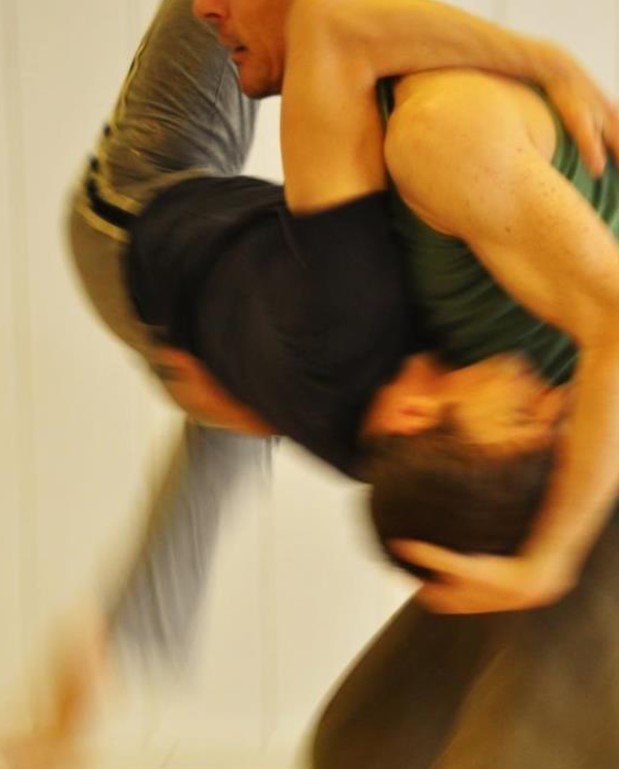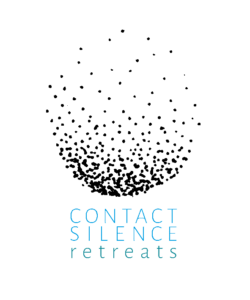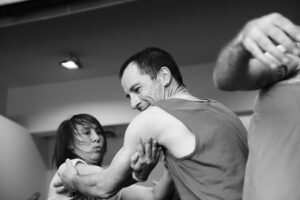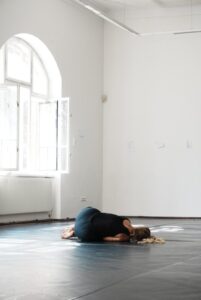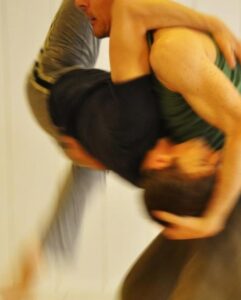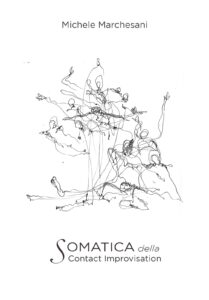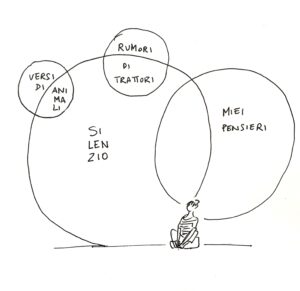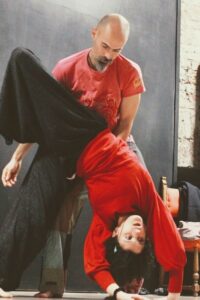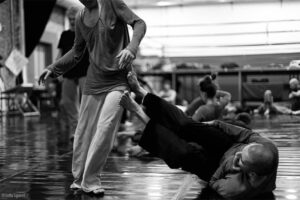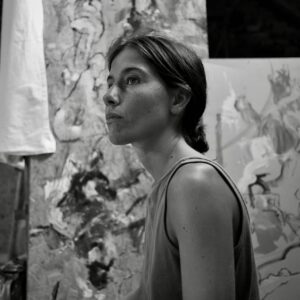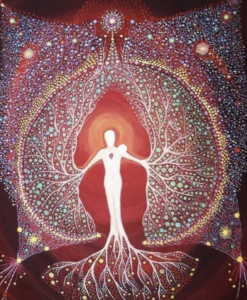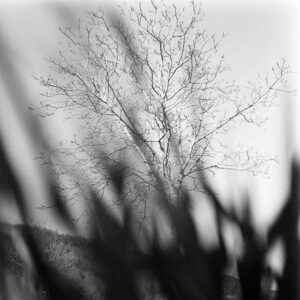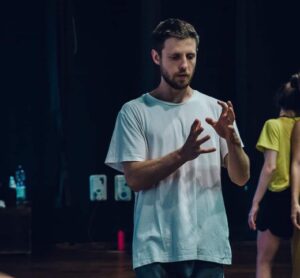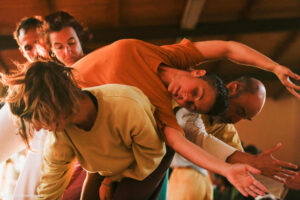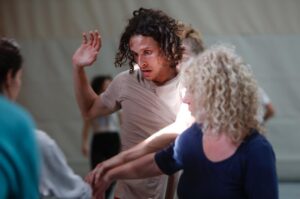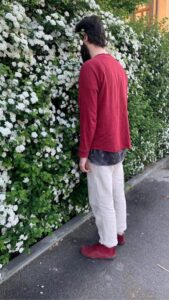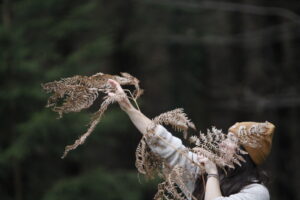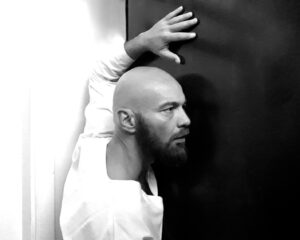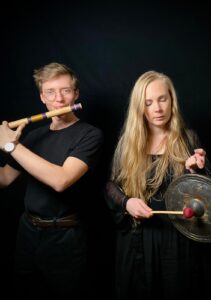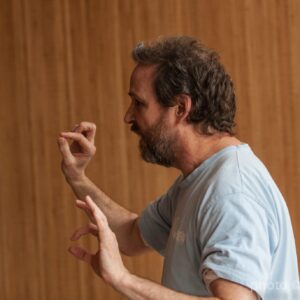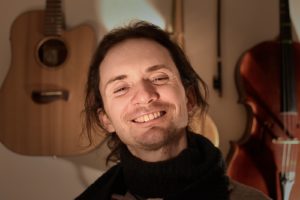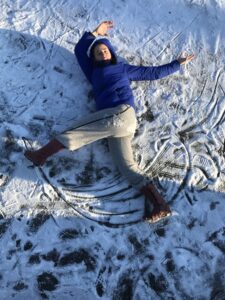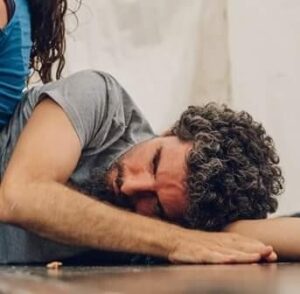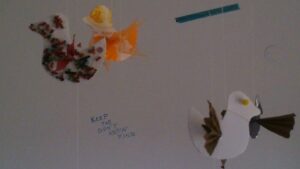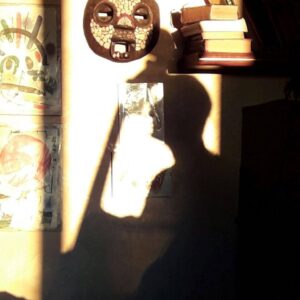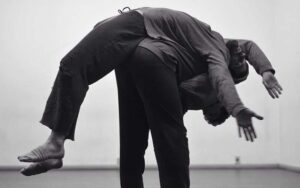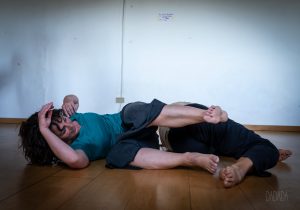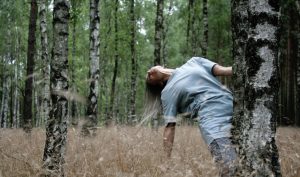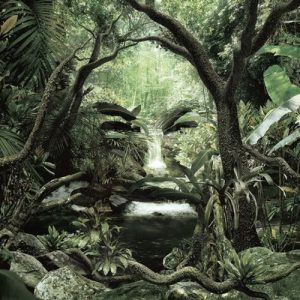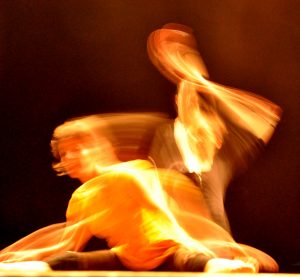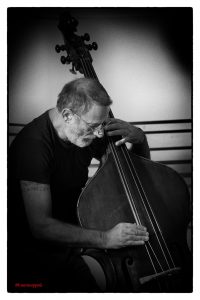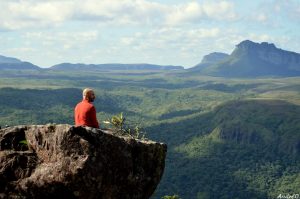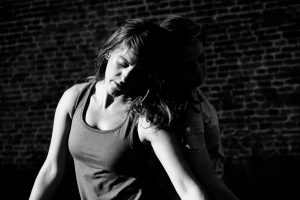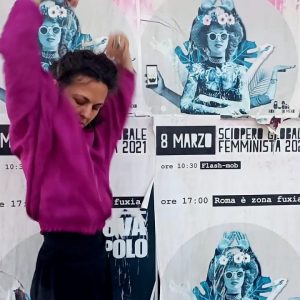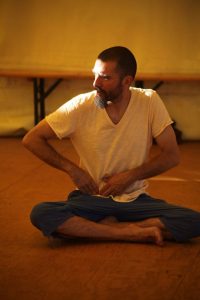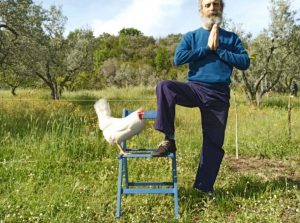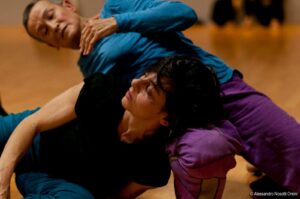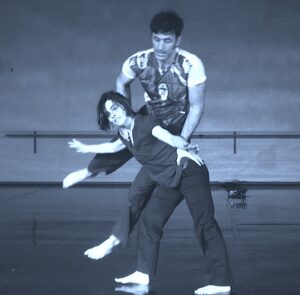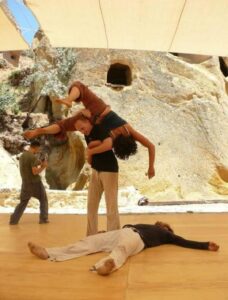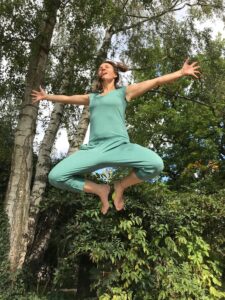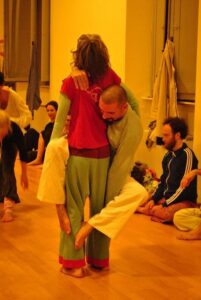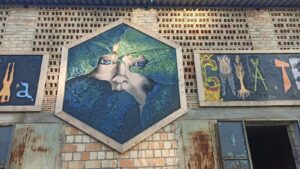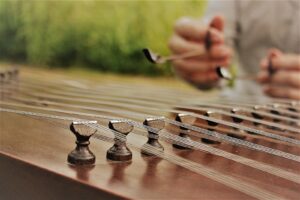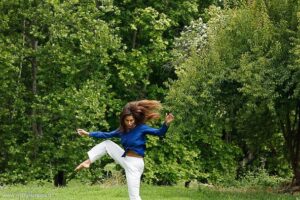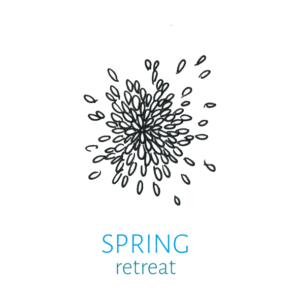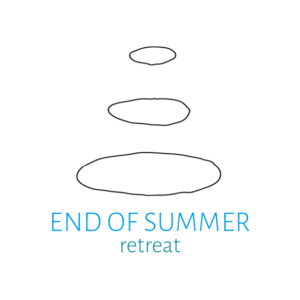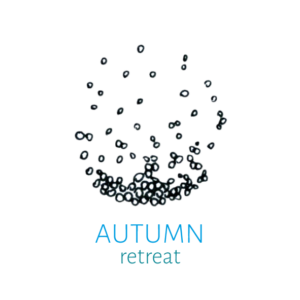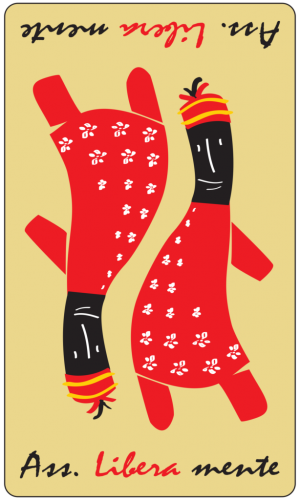Anna: I would just start saying why this interview. As many of you already know this place is welcoming contact improvisation because Deborah, the ‘mother’ of this place, is one of the first first people in Italy to dance contact improvisation, she literally brought CI from the United States to Italy.
That’s why when she had the idea to buy this place and make this structure that you enjoy now, she was already thinking about hosting events like this.
She values contact improvisation very much not only as a wonderful discipline of movement but also because it creates connection amongst people.
So, the idea of this interview would be to connect dots: every time we have a person who has been dedicating long part of their life to teaching or practicing contact improvisation, We’d like to make a bridge with the people and for the people who are living here, that maybe don’t know all the history and don’t practice contact. And also for you that instead are coming here to this place for the very fact that you are into CI. So Adrian thank you for teaching us during these three days the essentials of CI.Adrian: May I interrupt?
Anna: Of course.
Adrian: It’s what I consider as essential.
I will not call it the essential of CI. Just what I consider. I guess there are many different approaches.Anna: We felt that your teaching was essential to our practice and to improve it. You asked me not to say a lot about your biography, but let’s just say that Adrian has been teaching contact improvisation for almost 30 years.
Adrian: 25 years, but practicing for 30. I started in my home city in Switzerland. There was a festival happening since many years in my home city where different kinds of dance were offered and CI was one of the dance forms. Before discovering CI I did some martial art but I felt like kind of limited, not so creative. So I was changing to African dance because it seemed to me something very expressive, something creative, but I found myself just doing the form that the teacher told us.
Anna: How was it for you? love at first sight?
Adrian: Yes.
Anna: And did you struggle to find places where to dance or did you struggle with the practice itself?
Adrian: No. I missed the improvisation part in martial art and in African dance. Contact, wow, I can do contact. Wow, I can improvise. Perfect. This was the thing that really pulled me and I just loved it from the first moment. This was ‘92. Not so many possibilities to dance, but in Bern in my home city where I was living, there were some options to dance. And I never stopped. I did my very first workshop in 92 and then I couldn’t start immediately. I did the second workshop in 93 and then I never stopped.
Anna: And you also went through studying improvisation from different art forms. Right?
Adrian: I did a dance training in Freiburt/Germany.
Anna:That’s New Dance.
Adrian:New dance. Yes. It’s about free improvisation on stage. Dance technique and contact improvisation were just part of the teaching. The bigger part was performing instant composition.
Anna: And so over the years you dedicated time to teaching but also performing with your company.
Adrian: It was not my company. It was a collective of of five people.
Yes, for me it was clear: my focus is teaching. I never considered myself really as a performer or an artist. The teaching was my focus always and the performing was rather a kind of personal development to expose myself in front of an audience to deal with my shy side.
My goal was to become an improvisation teacher, not contact but performance improvisation. But economically wise, the contact classes and workshops just run much better. I had more people interested in contact improvisation and less in open improvisation. In a way I ended up being a contact teacher some years struggling with that because like the free improvisation on stage…it
was for me like the highest level of improvisation. So I was like: ‘ I’m just a contact teacher. I just let people roll around on and make them having a good time’.Anna: Do you think this affected the way you were teaching at the time? And when did this change inside of you?
Adrian: I guess it was a very slow change over the years where I discovered more and more the richness and the depth of CI and it was always something that was easy for me also to practice. I always had some struggle in performance and in instant composition. Contact improvisation is much more embedded in my body. The change happened little by little by little also by getting feedback from the people on how important my teaching is for them, how much they learned , how deep it was personal development happening. It was kind of a process over several years and me discovering more and more the depth of CI through my teaching. I was learning so much more through teaching than through taking classes.
Anna: And do you think there was a a turning point or a key discovery in your teaching/learning over the years that you remember vividly because it was a game changing moment?
Adrian: It was when I discovered fascia in 2012. And then I started to research myself and start to teach about it.
Anna: Have you seen in your experience as a teacher, some dramatic transformation in your students that happened fast or intensely with CI. They meet contact improvisation. They start learning and they experience a transformation in the practice and maybe also in the body and in the life. Was it like that for you?
Adrian: I guess that the transformation happened slowly. The body needs time. The habits of moving need time. But it was quite amazing our very first class in this festival on Thursday evening the non-grabbing, non-hooking, how the group really took this idea. It’s quite rare that I see such a clear effect of my teaching ”I don’t understand this sentence”
Of course I have some ideas of what I could teach but then my teaching is oriented very strongly on the group and I saw so much hooking and grabbing that I started to work with it.
I guess I’m not such a friend of dramatic changes as I believe in evolution.
Evolution. Slow evolution.
I guess it’s more human when it’s slow.
Anna: Yes, it is actually. And we were talking before in the dance studio about how no matter how what level of skills your student have, you stick to the same material. Can you go through this again -because some people were not there? It was very interesting what you said: no matter how experienced you are, there’s a ‘core of information’.
Adrian: My experience is that the material of contact improvisation is so complex in the end that you don’t understand it with one basic workshop or with two basic workshop, you don’t understand it after five years you don’t understand it after 10 years you have to research research explore explore repeat repeat make your own discoveries. I did three workshops with Nita Little: one after 10 years of practice, a second after 20 years of practice, one just last year – and every time it was new material. It was just unbelievable: what did I do in the first 10 years of my dancing? What did I do in the first 20 years? What am I teaching today? So it’s a constant process.
Anna: Do you think this endless learning depends on the fact that we continuously change or is it also in the nature of the practice as opposed to other practices for example, or do you think it’s alsobecause it’s open, there is no copyright.
Adrian: One reason is that they did not make a copyright trademark. As far as I know, for two reasons. First of all, they didn’t want to be the police. They didn’t want to control the thing and instead of making this they spread out information and then they created a newsletter that became eventually Contact Quarterly. So they gave out information because they were concerned about accidents happening by people who are not working properly with contact. So one reason was giving out information and the second reason is to not fix it. Keep it in development. If you start to trademark something you start to fix it.
So everybody can have ideas about contact and this I like and sometimes I hate it.
Anna: Why is that?
Adrian: Because sometimes I’m afraid that the core thing of what is meant with contact improvisation gets lost. It’s not just touching and moving.
And sometimes people tell me that they learned contact improvisation in five rhythms and it’s just touching and moving. They don’t have an idea of the specificity of this dance and I really have the impression since the pandemic that a lot of fusion things are happening, making events with many different sorts of ceremony, ecstatic dance, meditation, they get a little bit of contact improvisation and they think: oh now I know contact improvisation and they are not ready to commit to really learn what it could be.
Anna: What do you hope for the future of CI?
Adrian:That the specificity stays.
I guess Nita Little is a great example. She was one of the founders of CI. She was in this group that started to develop in 1972. So she’s dancing and teaching since more than 50 years. She made a
PhD. She’s a psychologist. She was researching about the body mind. So she’s really really developed in learning and still her teaching is so clearly contact improvisation, but it’s not the same as in the 70s or the 80s or the 90s. She’s adding knowledge, but it stays around the core element of contact improvisation. That is improvising. It’s not contact choreography. It’s not contact planning. It’s not contacting. It’s contact improvisation: ‘if you know what you will do next,
don’t do it’. This is me and it’s contact not through touch but contact through weight. So we are communicating through the weight and we touch in order to sense weight, not in order to sense skin or whatever.Anna: Back to the essentials.
Adrian: Yeah. Of course I think that what I’m teaching as essential is essential, but as there is no trademark nobody can make a definition of CI
Anna: If you were to describe it in one single word. What would it be?
Adrian: Sharing weight in motion? It’s only words. Sharing weight in improvised motion.
Anna: CI is by nature teaching something else on the side, which is connecting and being with people in close proximity, which develops a set of skills that people can bring outside the dance studio in their life and, just to sum up, to make life better for everyone on the planet. That said, what do you think this practice could have as a role? What role do you think it has in this time that we are
living? If it has one and if it has changed over time to your eye.Adrian: that’s a tough one. Maybe I will disappoint you. Sorry. It’s just dance.
Anna: It’s just dance.
Adrian: I got a kind of a disillusion that contact could change something. When I see the situation of the world…
Howard Thurman was a black US-philosopher, theologian, civil rightsleader, Christian mystic, influencing Martin Luther King He said something like
‘don’t ask what the world needs.
Ask yourself what makes you come alive and then go do it
because the world needs people who come alive’
I guess in the bigger picture you can think that people that are alive they probably do things that are good for the planet and the society.
Sometime people say if everybody danced contact it would be a better world ….the pandemic showed very clearly there was a lot of struggling inside the contact community, we did not agree about how to deal with the whole situation.
I guess we are not a community. We are not making common decisions.
it’s rather a network
Anna: What are you working on at the moment? Is there some new thing that you’re working on, some project, workshop that is coming up after this one?
Adrian: I just have my teaching program over the same series of workshops every year like some traditions and routine. Uh I’m a little bit a lonely wolf. I do just my stuff teaching my workshops and I’m more operating in the local networking there in Switzerland I’m busy with organizing jams, Swiss contact teachers meeting, things like that. in the teaching itself.
Audience: I have one question. Yeah. Because you talking about improvisation and performing. How do you see CI as a performance art?
Adrian: It was performance. The very first contact event was a performance in New York. So it was coming from dances. It was not a social dance. And then it turned quite quickly in some kind of social. I have some problems when people are dancing contact and some other people are watching and then they call it a performance. I miss the performative elements.
Adrian: So, watching a jam, watching an underscore jam, I don’t consider it as a performance. To be a performance, I need some instant composition elements like working with time space shape
and when the contact language is enriched with this instant composition then it can be super great
and it’s quite a challenge because there’s a thrill of moving in front of an audience that disturbs the communication between two bodies. So yeah it’s kind of tricky the contact performance.
I don’t know if nowadays you see pure contact performances. The first couple of years they had performances. They called it ‘come and see we show what we do’. Somehow this was the title of the performance. So they were kind of practicing contact improvisation in front of an audience
Of course in many festivals nowadays there are some performance nights, but I guess CI is not considered as a performance art by professional contemporary dancers.
The CI principles are now taught in dance schools. It’s part of curriculum of dance schools.But I guess that most contemporary dances underestimate so much what CI is.
They just get a taste of contact within their training.
One of the basic idea was to cut the hierarchy between choreographer and company. So Steve Paxton wanted the democratic way of cooperating to create pieces for the stage. So he had also kind of a political approach.
So you can can consider contact on a political level, on a psychological level, on a physical level, sports level, spiritual level. All these levels are included. But the basic approache to CI is through movement, through physics, through gravity. This is the approach and all the human aspects are included because we are human beings dancing a physical dance.
Anna: Thank you Adrian.
Anna: Comincerei dicendo perché stiamo facendo questa intervista. Come molti di voi già sanno, questo luogo accoglie il Contact Improvisation perché Deborah, la “madre” di questo posto, è stata una delle prime persone in Italia a danzare il Contact Improvisation. Ha letteralmente portato il CI dagli Stati Uniti in Italia.
Ecco perché, quando ha avuto l’idea di acquistare questo posto e creare la struttura che oggi state vivendo, stava già pensando di ospitare eventi come questo.
Lei attribuisce grande valore al Contact Improvisation, non solo come una meravigliosa disciplina di movimento, ma anche perché crea connessione tra le persone.
Quindi, l’idea di questa intervista è quella di collegare i punti: ogni volta che abbiamo una persona che ha dedicato gran parte della sua vita all’insegnamento o alla pratica del Contact Improvisation, vogliamo creare un ponte con le persone che vivono qui, che magari non conoscono la storia e non praticano il Contact. Ma anche per voi, che invece venite qui proprio perché siete appassionati di CI.
Quindi Adrian, grazie per averci insegnato, in questi tre giorni, gli elementi essenziali del CI.
Adrian: Posso interromperti?
Anna: Certo.
Adrian: È ciò che io considero essenziale. Non lo chiamerei “gli elementi essenziali del CI”. È solo la mia visione. Penso che ci siano molti approcci diversi.
Anna: Per noi il tuo insegnamento è stato essenziale per la nostra pratica e per migliorarla. Mi hai chiesto di non parlare molto della tua biografia, ma diciamo solo che Adrian insegna Contact Improvisation da quasi 30 anni.
Adrian: 25 anni, ma lo pratico da 30. Ho iniziato nella mia città natale in Svizzera, dove da molti anni si svolgeva un festival con diverse forme di danza, tra cui il CI.
Prima di scoprire il CI ho praticato alcune arti marziali, ma mi sentivo un po’ limitato, non così creativo. Così sono passato alla danza africana, perché mi sembrava qualcosa di molto espressivo e creativo, ma poi mi sono ritrovato semplicemente a riprodurre le forme che l’insegnante ci mostrava.
Anna: È stato amore a prima vista?
Adrian: Sì.
Anna: E hai avuto difficoltà a trovare luoghi dove danzare o a confrontarti con la pratica stessa?
Adrian: No. Sentivo la mancanza della parte di improvvisazione sia nelle arti marziali che nella danza africana. Con il Contact ho pensato: “Wow, posso fare contatto. Wow, posso improvvisare. Perfetto.” È stata proprio questa la cosa che mi ha conquistato fin dal primo momento.
Era il 1992. Non c’erano molte opportunità per danzare, ma a Berna, la mia città, c’erano alcune possibilità. E non ho mai smesso. Ho fatto il mio primo workshop nel ‘92, poi non ho potuto iniziare subito. Ho fatto il secondo nel ‘93 e da lì non mi sono più fermato.
Anna: E poi hai studiato improvvisazione in altre forme artistiche, giusto?
Adrian: Ho seguito una formazione in danza a Friburgo, in Germania.
Anna: Il cosiddetto New Dance?
Adrian: Sì, il New Dance. Si tratta di improvvisazione libera in scena. La tecnica della danza e il Contact Improvisation erano solo una parte dell’insegnamento. La parte più grande era la composizione istantanea in performance.
Anna: E così negli anni hai dedicato tempo all’insegnamento, ma anche alla performance con la tua compagnia.
Adrian: Non era la mia compagnia, era un collettivo di cinque persone. Per me era chiaro: il mio focus era l’insegnamento. Non mi sono mai considerato davvero un performer o un artista. L’insegnamento è sempre stato il mio obiettivo principale, mentre la performance era piuttosto un percorso di crescita personale, per espormi davanti a un pubblico e affrontare il mio lato timido.
Il mio obiettivo iniziale era diventare un insegnante di improvvisazione per la performance, non di Contact. Ma, dal punto di vista economico, i corsi e i workshop di Contact funzionavano molto meglio. C’era più interesse per il Contact Improvisation e meno per l’improvvisazione aperta.
Per alcuni anni ho lottato con questa cosa, perché per me l’improvvisazione libera in scena era il livello più alto di improvvisazione. Mi sentivo come se fossi “solo un insegnante di Contact”, come se stessi solo facendo rotolare le persone e facendole divertire.
Anna: Pensi che questo abbia influenzato il tuo modo di insegnare all’epoca? E quando è cambiato questo dentro di te?
Adrian: Credo sia stato un cambiamento molto lento nel corso degli anni. Ho scoperto sempre di più la ricchezza e la profondità del CI. Per me era sempre stato qualcosa di molto naturale da praticare, mentre ho sempre avuto difficoltà con la performance e la composizione istantanea. Il cambiamento è avvenuto poco alla volta, anche attraverso i feedback delle persone, che mi dicevano quanto il mio insegnamento fosse importante per loro, quanto avessero imparato, quanto fosse stato un processo profondo di crescita personale.
È stato un processo graduale e, insegnando, ho scoperto sempre di più la profondità del CI. Ho imparato molto di più insegnando che frequentando corsi.
Anna: C’è stato un momento chiave nel tuo insegnamento/apprendimento che ricordi come un punto di svolta?
Adrian: Quando ho scoperto la fascia nel 2012. Da lì ho iniziato a fare ricerca e ad insegnarla.
Anna: Nella tua esperienza da insegnante, hai visto trasformazioni rapide e intense nei tuoi studenti grazie al CI?
Adrian: Penso che la trasformazione sia lenta. Il corpo ha bisogno di tempo. Le abitudini di movimento hanno bisogno di tempo.
Ma è stato sorprendente vedere, già nella nostra prima lezione a questo festival, come il gruppo abbia assorbito il concetto di “non afferrare, non aggrapparsi”. È raro vedere un effetto così immediato del mio insegnamento.
Anna: Abbiamo parlato in studio del fatto che, indipendentemente dal livello di esperienza degli studenti, tu lavori sempre sullo stesso materiale. Puoi spiegare di nuovo questa idea?
Adrian: Il materiale del CI è così complesso che non si comprende con un solo workshop base, né con due. Non lo capisci dopo cinque anni, né dopo dieci. Devi ricercare, esplorare, ripetere, fare le tue scoperte.
Ho fatto tre workshop con Nita Little: uno dopo 10 anni di pratica, un altro dopo 20, l’ultimo l’anno scorso. Ogni volta era materiale nuovo. Mi chiedevo: “Cosa ho fatto nei primi 10 anni di danza? E nei primi 20? E cosa sto insegnando oggi?” È un processo continuo.
Anna: Questo apprendimento infinito dipende dal fatto che cambiamo continuamente o è insito nella pratica stessa?
Adrian: Una delle ragioni è che il CI non è stato registrato con un marchio. Non volevano essere dei “poliziotti” del CI. Preferivano diffondere informazioni e creare un bollettino, che poi è diventato Contact Quarterly.
Volevano dare informazioni per prevenire incidenti e, soprattutto, mantenere il CI in evoluzione. Se inizi a registrare un marchio, inizi a fissarlo.
Così tutti possono avere idee sul CI. E a volte questo mi piace, altre volte mi spaventa.
Anna: Perché?
Adrian: Perché ho paura che l’essenza del CI si perda. Non è solo toccarsi e muoversi.
E a volte le persone mi dicono di aver imparato il contact improvisation nei cinque ritmi, ed è solo toccarsi e muoversi. Non hanno idea della specificità di questa danza, e ho davvero l’impressione che, dalla pandemia in poi, stiano emergendo molte fusioni: eventi che combinano diversi tipi di cerimonie, ecstatic dance, meditazione… Prendono un po’ di contact improvisation e pensano: “Ah, ora conosco il contact improvisation”, ma non sono pronti a impegnarsi davvero per capire cosa possa essere.
Anna: Quali speranze hai per il futuro del CI?
Adrian: Che la sua specificità resti.
Penso che Nita Little sia un ottimo esempio. È stata una delle fondatrici del CI. Faceva parte del gruppo che ha iniziato a svilupparlo nel 1972. Quindi balla e insegna da più di 50 anni. Ha conseguito un dottorato, è psicologa, ha fatto ricerche sulla relazione tra corpo e mente. Quindi ha una conoscenza molto approfondita, eppure il suo insegnamento rimane chiaramente contact improvisation. Ma non è lo stesso degli anni ’70, ’80 o ’90: aggiunge conoscenza, ma resta ancorato al nucleo centrale del contact improvisation.
E il nucleo è l’improvvisazione. Non è coreografia di contatto. Non è pianificazione del contatto. Non è semplicemente “contattarsi”. È contact improvisation: “se sai già cosa farai dopo, non farlo”.
Questo è ciò che intendo io. Ed è contatto non attraverso il tatto, ma attraverso il peso. Comunichiamo attraverso il peso e ci tocchiamo per percepirlo, non per sentire la pelle o altro.Anna: Tornare all’essenziale.
Adrian: Sì. Ovviamente quello che insegno come essenziale è, per me, essenziale. Ma siccome non esiste un marchio registrato, nessuno può stabilire una definizione fissa di CI.
Anna: Se dovessi descriverlo in una sola parola, quale sarebbe?
Adrian: Condivisione del peso in movimento? Sono solo parole. Condivisione del peso in movimento improvvisato.
Anna: Il CI, per sua natura, insegna anche qualcos’altro: la connessione e la vicinanza con le persone, sviluppando competenze che si possono portare nella vita quotidiana, migliorando la vita di tutti. Detto questo, quale ruolo pensi possa avere questa pratica nel nostro tempo? Se ne ha uno, e se ai tuoi occhi è cambiato nel tempo.
Adrian: Questa è difficile. Forse ti deluderò. Mi dispiace. È solo danza.
Anna: È solo danza.
Adrian: Ho perso l’illusione che il contact potesse cambiare qualcosa. Guardando la situazione del mondo…
Howard Thurman, un filosofo e teologo statunitense, leader per i diritti civili e mistico cristiano che ha influenzato Martin Luther King, ha detto qualcosa come:
“Non chiederti di cosa ha bisogno il mondo.
Chiediti cosa ti fa sentire vivo e poi fallo.
Perché il mondo ha bisogno di persone che si sentano vive.”Credo che, in una visione più ampia, si possa pensare che le persone vive facciano cose buone per il pianeta e per la società.
A volte sento dire: “Se tutti ballassero contact, il mondo sarebbe un posto migliore”. Ma la pandemia ha mostrato molto chiaramente che dentro la comunità del contact ci sono stati molti conflitti, non eravamo d’accordo su come affrontare la situazione.Non siamo una comunità. Non prendiamo decisioni comuni.
È più che altro una rete.
Anna: Su cosa stai lavorando al momento? Hai qualche nuovo progetto o workshop in arrivo?
Adrian: Ho semplicemente il mio programma di insegnamento, sempre la stessa serie di workshop ogni anno, come una tradizione, una routine.
Sono un po’ un lupo solitario. Faccio le mie cose, insegno i miei workshop e mi muovo più a livello locale, in Svizzera. Sono impegnato nell’organizzazione di jam, incontri tra insegnanti di contact svizzeri, cose del genere.Pubblico: Ho una domanda. Hai parlato di improvvisazione e performance. Come vedi il CI come arte performativa?
Adrian: È nato come performance. Il primo evento di contact è stato una performance a New York. È nato dalla danza, non era una danza sociale. Poi si è trasformato abbastanza rapidamente in qualcosa di più sociale.
Ho qualche difficoltà quando le persone danzano contact, altre persone li guardano e lo chiamano “performance”. Mi manca l’elemento performativo.
Guardare una jam o un underscore jam, per me, non è una performance. Per essere una performance, servono elementi di composizione istantanea, come lavorare con il tempo, lo spazio, la forma.
Quando il linguaggio del contact si arricchisce di questa composizione istantanea, allora può essere davvero eccezionale.
Ed è una bella sfida, perché il brivido di muoversi davanti a un pubblico può disturbare la comunicazione tra due corpi. Quindi sì, è una cosa complessa la performance di contact.
Non so se oggi esistano ancora performance di contact puro. Nei primi anni si facevano performance intitolate “Venite a vedere, vi mostriamo cosa facciamo”. Questo era il titolo. In pratica, praticavano contact improvisation davanti a un pubblico.
Ovviamente oggi in molti festival ci sono serate di performance, ma credo che il CI non venga considerato come arte performativa dai danzatori contemporanei professionisti.
I principi del CI ora vengono insegnati nelle scuole di danza, fanno parte del curriculum delle scuole di danza. Ma penso che la maggior parte dei danzatori contemporanei sottovaluti enormemente il CI.
Ne hanno solo un assaggio all’interno della loro formazione.
Uno degli obiettivi iniziali del CI era abbattere la gerarchia tra coreografo e compagnia. Steve Paxton voleva una modalità democratica di collaborazione per creare pezzi da portare in scena. Aveva anche un approccio politico.
Quindi il contact può essere visto a livello politico, psicologico, fisico, sportivo, spirituale. Tutti questi livelli sono inclusi.
Ma l’approccio di base al CI è attraverso il movimento, la fisica, la gravità.
Tutti gli aspetti umani sono inclusi, perché siamo esseri umani che danzano una danza fisica.
Anna: Grazie, Adrian.
